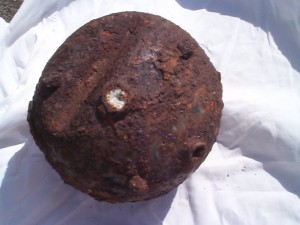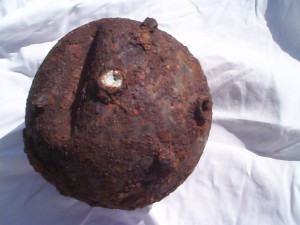Please post your comments if you have some useful input!!
[Note Civil War soldiers referred to what we know as land mines as either "land torpedoes" or "sub-terra" shells or mines.]
Fellow reader Drew Armstrong notified me of an “unknown object” that was found near Palatka, Florida, and the St. John’s River. The object appears to from the Civil War era and at first guess I was thinking a sub-terra torpedo such as the ones I investigated during my research of the Battle of Fort Blakely. However, after some research I am fairly positive it is a sea Torpedo. First, after careful study it seems to fit the description I found in the Official Records. Also, this area of the St. John’s River did see some naval action. For example:
In March 1864 Palatka, Florida, was described by a US Naval Commander as nothing more than “a village on the west bank of the St. Johns fifty miles south of Jacksonville—is occupied by four Federal regiments supported by several gunboats. No opposition is encountered. The Federal troops fortify their position.”
Here’s a description of an event that took place about the same time as the above log entry:
In March, 1864, the gun-boats in Florida, under the command of Commander George B. Balch, were participating in the expedition up the St. John’s River. When the Federal troops landed, they threw up such heavy intrenchments that it was not likely the Confederates could make much impression on them. The Confederates of that region, however, did not propose to allow their native State to be invaded without making a stubborn resistance, and left no means untried to annoy the military positions whenever there was an opportunity of doing so. But the gun-boats were generally at hand with their heavy guns and bursting shells, and the Southerners were usually discomfited.
General Gordon landed at Jacksonville on the 9th of May, and assumed command of the district of Florida; and, in view of the long line of river to be kept open, objected to any reduction of the naval force in the St. John’s River, in which Commander Balch concurred with him.
The activity of the Confederates in this quarter, as elsewhere, was very marked ; for, though they yielded up all the forts along the coast, they seemed determined to resist any further entrance of Federal troops into the interior of the State, and they tried to confine the Navy as much as possible to the lower part of the St. John’s River.
Notwithstanding the vigilance of the naval commanders, the Confederates succeeded in planting torpedoes in the river in the channel. On May 10th, the steamer “Harriet A. Weed” ran into two of these torpedoes, which exploded at the same moment and completely destroyed the vessel, sinking her in less than one “minute’s time, with five men killed and ten badly wounded.
The naval force employed in the St. John’s River, under Commander Balch, was composed of the “Pawnee,” “Mahaska” and “Norwich.” off Jacksonville, and the “Ottawa ” at Palatka. With such a small force it would have been impossible to prevent the enemy from practicing their system of torpedo warfare, which they had found to be so effective wherever the Federal gunboats were employed.
On about the last of March, the transport “Maple-leaf” offered another success for the Confederates, and was blown up by a torpedo, fifteen miles above Jacksonville— this being the highway to Palatka and above, where Federal troops were being constantly transported. The duty on the river became very hazardous, for a severe torpedo warfare was carried on in small boats during dark nights by the Confederate torpedo corps, which first made its appearance on the Mississippi in 1862.
The above operations in Florida of the Army and Navy lasted from March 6th to April 16th. when orders were received from the War Department for the troops to be sent North, in consequence of which the gun-boats were withdrawn ; but while employed with the Army, Commander Balch, Lieutenant – Commander S. Livingston Breese, of the ” Ottawa,” and the commanders of the “Mahaska” and “Norwich ” performed good and gallant service.
Drew had the photos analyzed by historians at James Madison University and their shockingly incorrect analysis can be viewed here . According to them, it can’t be a sub-terra shell as the Confederates stopped using them in 1862!! Wow. Anyway…
Here are the images of the potential Civil War Torpedo (click to enlarge):


Chris, what are the dimensions? Diameter, circumference, size of the open hole to the right? How thick are the walls? How many lugs stand out on the surface? Do they appear symmetrical?
Hard to gauge the size of the artifact without a reference (ruler or a pencil) in the photo. My initial thoughts were an older Spanish mortar shell (perhaps dating to colonial times) with the “ears” rusted off.
However, if there are more lugs around the surface, this may be the internal portion of a Civil War Navy Pevey shell.
Craig.
Craig I have passed on your question about its dimensions and am waiting for a response from the owner of the device.
Chris
I did not measure it however it was about the size of a regulation soccer ball. I hope this helps!
Please note my new email address (different from the one used on previous emails)
williamdrewarmstrong@gmail.com
Given the size estimate and the exterior profile, this looks less and less to be a torpedo, and more to be either a limited use projectile (Pevey) or a non-Civil War artifact.
Note that the Pevey shell was used by the Navy in some ships of the South Atlantic Blockading Squadron. Some examples have been recovered outside Savannah where the very same ships mentioned in the original post saw activity. You might post the photos on the CW Projectiles forum. (where there is a thread discussing the Pevey, BTW – http://cwpforums.com/forum/viewtopic.php?t=1137&highlight=&sid=6427d3f80754dfc31c98dee6f13b8ea6 )
Craig thanks so much for contributing here and helping us out! I will check out that link, thanks again! Chris